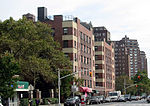St. Rose of Lima Old Church (New York City)
The Old Church of St. Rose of Lima is a former Roman Catholic parish church which was under the authority of the Roman Catholic Archdiocese of New York, located at 36 Cannon Street between Broome Street and Delancey Street in the Lower East Side of Manhattan, New York City. The rectory was located at 42 Cannon Street; the school was located at 290 Delancey Street. The 1871 church was described by The New York Times when it opened in 1871, as one of the finest churches in the city. The church was demolished around July 1901 and the site redeveloped in conjunction with the erection of the Williamsburg Bridge (1903) and public housing. A new church was begun shortly after property was purchased in July 1900 at Grand and Lewis Streets. The parish closed in the 1960s.
Excerpt from the Wikipedia article St. Rose of Lima Old Church (New York City) (License: CC BY-SA 3.0, Authors).St. Rose of Lima Old Church (New York City)
Delancey Street, New York Manhattan
Geographical coordinates (GPS) Address Nearby Places Show on map
Geographical coordinates (GPS)
| Latitude | Longitude |
|---|---|
| N 40.71636 ° | E -73.98001 ° |
Address
Delancey Street 280
10002 New York, Manhattan
New York, United States
Open on Google Maps








